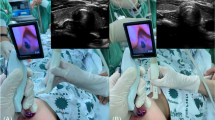Abstract
Purpose
Extubation laryngospasm is frequently encountered in children undergoing upper airway surgery. Different drugs and techniques have been used for its treatment. The objective of this study was to examine gentle chest compression as an alternative to standard practice for relief of laryngospasm.
Methods
This study was conducted over 4 years on all children scheduled for elective tonsillectomy. During the first 2 years, extubation laryngospasm was managed with 100% O2 with gentle positive pressure ventilation via a tight-fitting face mask (Standard-Practice Group), whereas in the following 2 years; laryngospasm was managed with 100% O2 and concurrent gentle chest compression (Chest-Compression Group). In both groups, if the spasm was not relieved and oxygen saturation decreased to 85%, IV succinylcholine was administered with subsequent manual ventilation.
Results
During the 4-year study period, 1226 children aged 3–12 years were studied. In the chest-compression group, 46/594 children (7.8%) developed laryngospasm compared with 52/632 children (8.2%) in the standard group (P = 0.84). Significantly more children who developed laryngospasm were successfully treated by chest compression 34/46 (73.9%) compared with those managed by the standard method 20/52 (38.4%); (P < 0.001). None of the children in the chest-compression group developed gastric distension compared with 45/52 (86.5%) in the standard group.
Conclusion
Gentle chest compression with 100% oxygen is a simple and effective technique for immediate management of post extubation laryngeal spasm in children.
Similar content being viewed by others
References
Olsson GL, Hallen B. Laryngospasm during anaesthesia. A computer-aided incidence study in 136,929 patients. Acta Anaesthesiol Scand. 1984;28:567–75.
Koç C, Kocaman F, Aygenç E, Ozdem C, Cekiç A. The use of perioperative lidocaine to prevent stridor and laryngospasm after tonsillectomy and adenoidectomy. Otolaryngol Head Neck Surg. 1998;118:880–2.
Tsui BC, Wagner A, Cave D, Elliott C, El-Hakim H, Malherbe S. The incidence of laryngospasm with a ‘‘No Touch’’ extubation technique after tonsillectomy and adenoidectomy. Anesth Analg. 2004;98:327–9.
Gulhas N, Durmus M, Demirbilek S, Togal T, Ozturk E, Ersoy MO. The use of magnesium to prevent laryngospasm after tonsillectomy and adenoidectomy: a preliminary study. Paediatr Anaesth. 2003;13:43–7.
Roy WL, Lerman J. Laryngospasm in paediatric anaesthesia. Can J Anaesth. 1988;35:93–8.
Afshan G, Chohan U, Qamar-Ul-Hoda M, Kamal RS. Is there a role of a small dose of propofol in the treatment of laryngeal spasm? Paediatr Anaesth. 2002;12(7):625–8.
Sibai AN, Yamout I. Nitroglycerin relieves laryngospasm. Acta Anaesthesiol Scand. 1999;43(10):1081–3.
Chung DC, Rowbottom SJ. A very small dose of suxamethonium relieves laryngospasm. Anaesthesia. 1993;48:229–30.
Warner DO. Intramuscular succinylcholine and laryngospasm. Anesthesiology. 2001;95:1039–40.
Pearce H. Laryngeal spasm. Anaesth Intensive Care. 1983;11(4):389–90.
Rex MAE. A review of the structural and functional basis of laryngospasm and a discussion of the nerve pathways involved in the reflex and its clinical significance in man and animals. Br J Anaesth. 1970;42:891–9.
Nishino T, Ishikawa T, Tanaka A, Hiraga K. Respiratory responses to chest compression in human subjects. Am Rev Respir Dis. 1992;146:980–4.
Fisher MM, Whaley AP, Pye RR. External chest compression in the management of acute severe asthma- a technique in search of evidence. Prehosp Disaster Med. 2001;16:124–7.
Culver GA, Rahn H. Reflex respiratory stimulation by chest compression in the dog. Am J Physiol. 1952;168:686–93.
D’Angelo E, Miserocchi G, Agostoni E. Effect of rib cage or abdomen compression at iso-lung volume on breathing pattern. Respir Physiol. 1976;28:161–77.
McIlroy MB, Butler J, Finley TN. Effect of chest compression on reflex ventilatory drive and pulmonary function. J Appl Physiol. 1962;17:701–5.
Owen H. Postextubation laryngospasm abolished by doxapram. Anaesthesia. 1982;37:1112–4.
Hannam S, Ingram DM, Rabe-Hesketh S, Milner AD. Characterisation of the Hering–Breuer deflation reflex in the human neonate. Respir Physiol. 2000;124:51–64.
Alalami AA, Ayoub CM, Baraka AS. Laryngospasm: review of different prevention and treatment modalities. Pediatr Anesth. 2008;18:281–8.
Van der Walt J. Laryngospasm. In: Bissonnette B, Dalens B, editors. Pediatric anesthesia: principles & practice. New York: McGraw Hill; 2002. p. 644.
Landsman IS. Mechanisms and treatment of laryngospasm. Int Anesthesiol Clin. 1997;35:67–73.
Silva DA, Sanders I. Continuous positive airway pressure as a promoter of laryngospasm during halothane anesthesia. Ann Otol Rhinol Laryngol. 1992;101:893–6.
Hampson-Evans D, Morgan P, Farrar M. Pediatric laryngospasm. Paediatr Anaesth. 2008;18:303–7.
Author information
Authors and Affiliations
Corresponding author
About this article
Cite this article
Al-Metwalli, R.R., Mowafi, H.A. & Ismail, S.A. Gentle chest compression relieves extubation laryngospasm in children. J Anesth 24, 854–857 (2010). https://doi.org/10.1007/s00540-010-1036-9
Received:
Accepted:
Published:
Issue Date:
DOI: https://doi.org/10.1007/s00540-010-1036-9




